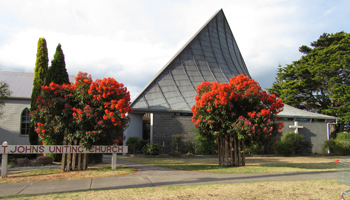Cowes, Phillip Island
The Church of St John,- Fisherman and Apostle -
MINISTERS :- THE MEMBERS OF THE CONGREGATION

History of the Congregation (This page is under development)
The land and the garden.We acknowledge that the traditional custodians of the land on which the church stands are the Bunurong people.
In 1869, soon after the town was surveyed, this section of land was granted to the Presbyterian Church. The church buildings stand in a lovely garden setting. On the Warley Avenue boundary there are two big golden cypress trees, which were planted by the Rev. James Raff and his wife Charlotte during their ministry in this parish (1928-34).
The bell-tower and memorial garden are of special interest. The bell-tower, dedicated on 10th June 1983, houses the historic bell from the sailing ship ‘Speke’ which was wrecked on a rocky prominence off Kitty Miller’s Bay on 22nd February 1906. Built in 1891, at the time of its loss the Speke was the largest steel three-masted fully-rigged ship in the world. All but one of the crew were rescued from the wreck and in gratitude for ‘the kindness shown by the People of the Island’ the bell was given in trust to the Presbyterian Church. It has been used since then to call people to worship. Beginning in 1939 the Island’s first Fire Brigade housed the fire engine and equipment on the church property and the Speke bell was used as the fire alarm.
The memorial garden links the present church community with those who have gone before, who have worshipped and worked here. The bell-tower has memorial plaques, and there are three memorial stones of Woolamai granite in the garden which contains aromatic plants such as rosemary, which is traditionally for remembrance.
The Church and Hall.
The original wooden church, now the hall, was built in 1895. The annexe, separated from the main hall by timber folding doors, was added in 1929. The modern church was completed in 1975, and the soaring roof line was then easily seen from the sea—a great landmark. The architect, Paul Archibald, had designed a similar church at Rosebud on the Mornington Peninsula. The concept of the distinctive copper roof is that of the keel of a ship. The building of the roof proved to be a complex challenge – Jim Jeffrey oversaw the project, with builders Donald McRae, Jim Mitchell and members of their families.
The Foyer.
The Shearwaters (also known as mutton birds) return to Phillip Island every year—to their second home. The wall-hanging in the foyer shows the name tags of all our Shearwaters, the many people who are a special part of the church community as they return often to the Island for rest and recreation. Let us know if you would like to be added to the list of Shearwaters. The painting of the church is by David Williams.
The Church Interior.
On the north and south sides of the church the timber-lined roof sweeps down to meet the walls. A narrow band of specially created stained glass runs along the top of these walls. This was designed by Josie Kent and crafted by Lawrie Pyke. The vivid colours are those of the Island—in the sun, the sea, the flora and fauna, and all the natural beauty of God’s creation.
From very ancient times the Church has been likened to a ship. Often the main part of the church interior is called the nave, from the Latin navis, a ship. Our sail was donated by Jack and Wendy Sheppard, and it has often sailed in these waters.
Great Pilot of my onward way, You will not let me drift.’
(Jessie Adams).
The communion table and the pulpit were made by Donald and Bob McRae for the new church. The standing cross was made later by Bob McRae. The wooden pews, the font and the two elders’ chairs are from the Murrumbeena Methodist Church.
The large baler shell which holds the baptismal water was given by the Deepdene Presbyterian Fellowship (young people) in 1974. This tropical shell, melo amphora, of the family Volutidae, can be found from southern Queensland to Shark Bay in Western Australia. It was a valuable trade item between inland and coastal Aboriginal people. It has a large water-carrying capacity and has been used as a water carrier and baler in canoes throughout the Pacific and in Australia.
The lectern for the reading of the Bible was presented in 1968 by J.W.Gliddon, (compiler of Phillip Island in Picture and Story). On the front is a carved medallion of a ship with wind filling the sails. This ship with the cross on the sail ‘symbolizes the Gospel sailing out on the sea of the World.’ It is a reminder that the ship was the lifeline of Phillip Island for the first hundred years of its life after settlement. The timber was the gift of K.G.West and the carving the work of Arthur E. Woodley.
A tall banner hung from one of the pillars marks the season of the church year. Violet, white and green are the three principal liturgical colours used to mark the cycle of the church year. Violet (or purple) is used for Advent and Lent, white (or gold) for Christmas and Easter, and green for the remaining time. Red is used for special days. The banners are the work of Stella Watson, Gwen McRae, Esther Gassmann, and others.
Approximately 23 million short-tailed shearwaters, breed in about 285 colonies in southeastern Australia from September to April.

